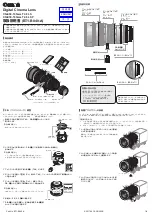15
7. When the camera mounting frame assembly is secured to the surface, apply an epoxy security
sealant around the perimeter of the base plate assembly where it meets the ceiling/wall. [Vicon
recommends DynaPoxy™ EP1200 (US) or Arbokol 1025 (UK) or equivalent for this purpose.]
Cable Connections
All cabling is done to the boards located on the back of the front plate.
Note: Vicon systems and components, like most electronic equipment, require a clean, stable power
source. Voltage irregularities such as surges, drops, and interruptions can affect the operation of your
equipment and, in severe cases, damage certain components.
Analog Cable Connections
1. Connect the power cable to the 2-postion terminal block. The camera accepts 24 VAC (or 12 VDC)
and polarity is not relevant.
2. Connect the coaxial cable for video output to the BNC connector.
3. To adjust the intensity of the LED illuminators, use switch slides. The factory setting is for
maximum intensity.
4. Connect the device to the AO (Alarm Out) and G (Ground) terminal block connectors. Alarm Out:
can activate external devices such as buzzers or lights.
IP Cable Connections
1. Use the RJ-45 connector if powering the camera using PoE. If using 24 VAC (or 12 VDC), connect
the power cable to the 2-postion terminal block. Connect the positive (+) pole to the ‘+’ position
and the negative (-) pole to the ‘-’ position. Use certified/Listed Class 2 power source only.
2. Video and data are transmitted via the RJ-45 connector. Generally a cross-over cable is used for
direct connection to PC, while a direct cable is used for connection to a hub
.
3. To adjust the intensity of the LED illuminators, use web control. The factory setting is for maximum
intensity.
4. Alarm connections: AI (Alarm In): External devices can signal the network camera to react on
events. Mechanical or electrical switches can be wired to the AI (Alarm In) and G (Ground) terminal
block connectors. G (Ground): Connect the ground side of the alarm input and/or alarm output to
the G (Ground) connector. Alarm Out: The network camera can activate external devices such as
buzzers or lights. Connect the device to the AO (Alarm Out) and G (Ground) terminal block
connectors.
5. Connecting Video Output: Video Output is provided for an easy zoom and focus control when
adjusting lens. Connect your Video cable unit to J5 on the board.
Final Installation
When all connections are made, secure the front plate to the base plate using the security screws
previously removed using no. 20 Torx bit.
Summary of Contents for Series 247-00-03
Page 8: ...8 2 Installation 2 1 Parts and Description ...
Page 11: ...11 IP Camera Analog Camera ...
Page 12: ...12 IP Camera Analog Camera ...
Page 34: ...34 3 5 2 Video Image Basic Refer to 3 5 1 Basic Configuration Video Image for more details ...
Page 37: ...37 3 5 3 Audio Refer to 3 5 1 Basic Configuration Audio for more details ...


















